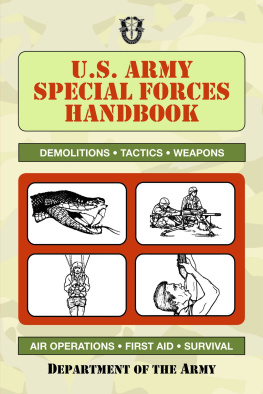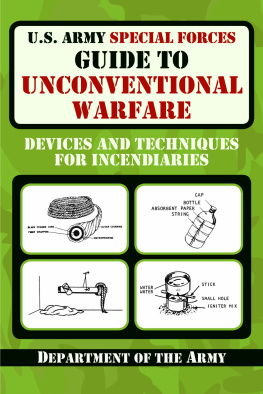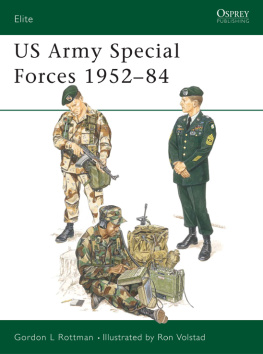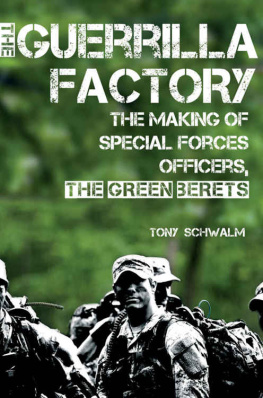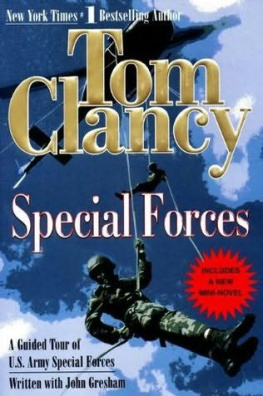
ALSO BY DICK COUCH
Nonfiction
The Warrior Elite
The Finishing School
Down Range
The U.S. Armed Forces
Nuclear, Chemical, and
Biological Survival Manual
Fiction
SEAL Team One
Pressure Point
Silent Descent
Rising Wind
The Mercenary Option
Covert Action
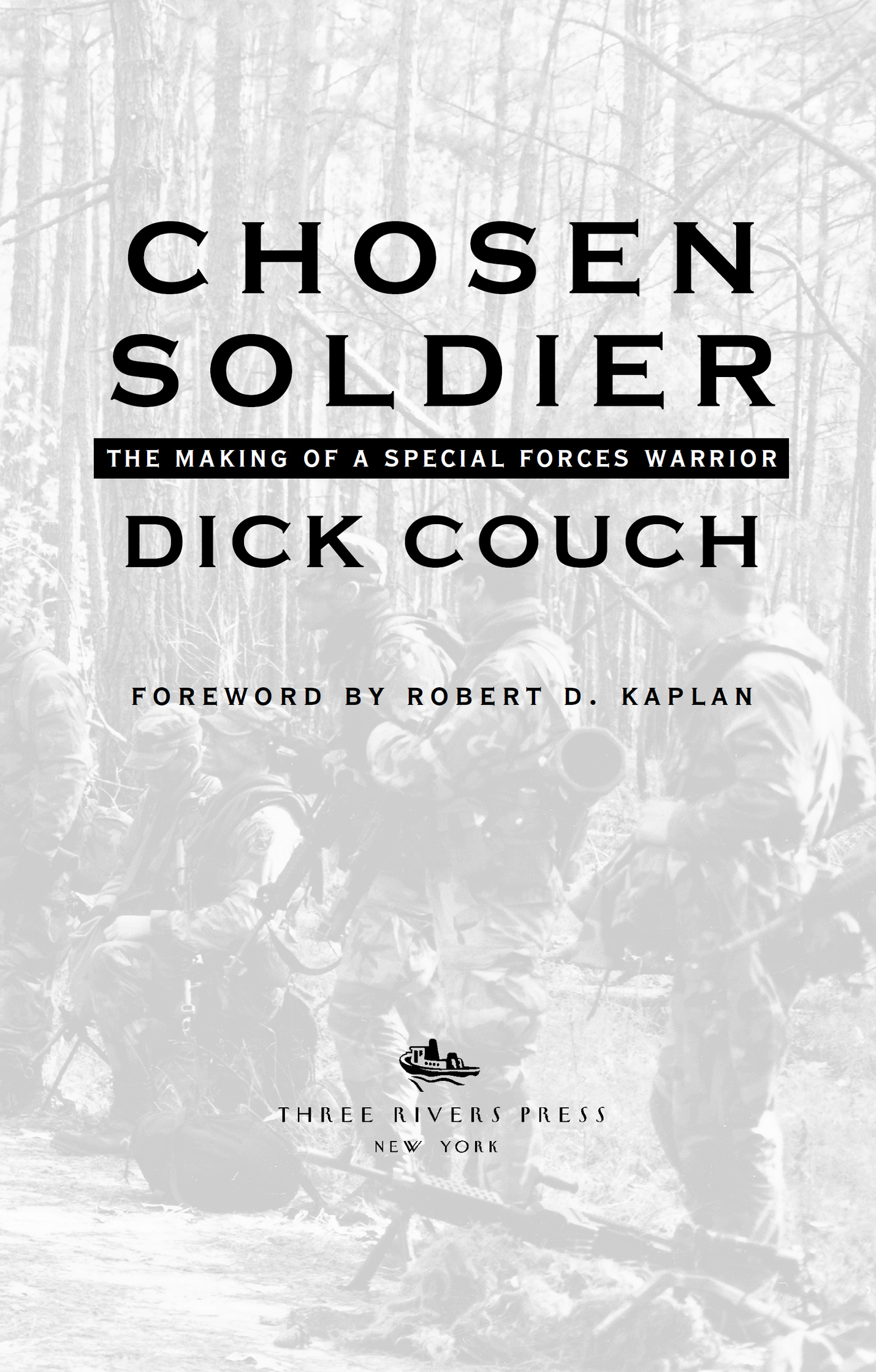
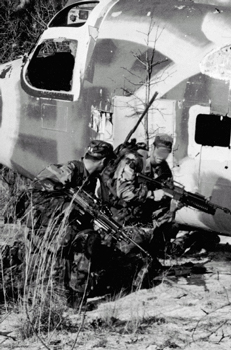
Copyright 2007 by Dick Couch
Foreword copyright 2007 by Robert D. Kaplan
All rights reserved.
Published in the United States by Three Rivers Press, an imprint of the Crown Publishing Group, a division of Random House, Inc., New York.
www.crownpublishing.com
Three Rivers Press and the Tugboat design are registered trademarks of
Random House, Inc.
Originally published in hardcover in the United States by Crown Publishers,
an imprint of the Crown Publishing Group, a division of
Random House, Inc., New York, in 2007.
Library of Congress Cataloging-in-Publication Data
Couch, Dick, 1943
Chosen soldier : the making of a Special Forces warrior / Dick Couch;
foreword by Robert D. Kaplan.
1. United States. Army. Special Forces. I. Title.
UA34.S64C68 2006
356.16dc22 2006020623
ISBN9780307339393
Ebook ISBN9780307394798
v3.0_r4
CHAPTER 1
SPECIAL FORCES 101HISTORY, TRAINING, AND ORGANIZATION
CHAPTER 2
RECRUITING THE UNCONVENTIONAL
CHAPTER 3
THE PREPARATION
CHAPTER 4
THE SELECTION
CHAPTER 5
SPECIAL FORCES TACTICS
CHAPTER 6
THE 18 SERIES
CHAPTER 7
THE DETACHMENT COMMANDER
CHAPTER 8
ROBIN SAGE
This book is dedicated to the volunteersthe young men who join up to become special operations warriors. They are talented, capable, motivated, and intelligent, and all that America has to offer lies before them. Yet these patriots choose to enlist. They turn away from civilian opportunity and fortune for a life of sacrifice, struggle, danger, and service. And because they choose to serve, the rest of us are free to enjoy the bounty of this great nation. God bless and protect these gallant volunteers.
Whom shall I send, and who will go for us?
Then I said, Here am I. Send me.
ISAIAH 6:8
INSCRIPTION ON THE DOG TAG RESTING ON THE FLAG-DRAPED, HOMEWARD-BOUND CASKET OF AN AMERICAN SPECIAL OPERATIONS WARRIOR KILLED IN ACTION IN AFGHANISTAN, JULY 2005

ACKNOWLEDGMENTS
I d like to thank those in the Army and Army special operations chain of command who allowed me such full and complete access to Special Forces training. A special thanks is due to two commanding generals of the JFK Special Warfare Center and SchoolMajor General Geoffrey Lambert (ret.), who approved the project, and Major General James Parker, who supported my work while he was in command. And start to finish, Colonel Manny Diemer, Commander, 1st Special Warfare Training Group, was always there to help. I especially want to acknowledge and thank the many cadre team sergeants and officers who made time for me while they went about the deadly serious business of training tomorrows Special Forces chosen soldiers.
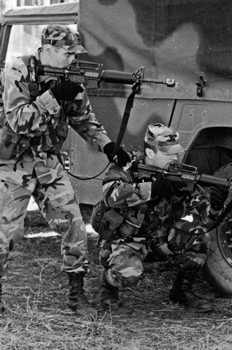
FOREWORD
ROBERT D. KAPLAN
I n the days and weeks after 9/11, the Pentagon scrambled for options to take down the Taliban regime in Afghanistan. The most practical and available method turned out to be deploying the A-Teams of United States Army Special Forces, popularly known as the Green Berets. It wasnt that these twelve-man detachments were necessarily the greatest commandos the armed forces could muster: rather, it was that they were the most adaptable. Whereas Navy SEALs and Army Rangersto cite two examplesmight kick in doors faster, the Green Berets could do that very well, too, as well as deal more effectively with indigenous forces of a very different culture: something that took patience, maturity, and a knack for diplomacy. The twelve-man team, which could divide into two six-man teams because of its duplication of occupational specialties, was also a perfect bureaucratic instrument that had survived throughout the decades.
Afghanistan brought Army Special Forces, or SF as its known within the special operations community, full circle from the Vietnam days, involving SF in both training and fighting with indigenous forces for the first time since the 1960s and early 1970s. Since the Afghanistan campaign, Green Berets have not only fought some of the most difficult battles in Iraq, but havent let up around the world with their training missions, which are the bread and butter of SF.
In Chosen Soldier, Dick Couch takes us to the heart of the Special Forces world, focusing on how an Army Special Forces soldier is created. You cant understand SF unless you delve into the training behind it, which, in turn, reveals the cultural mentality of this branch of the Special Operations community. Thus, this is an essential book.
Never before has SF been so prominent, and, therefore, never before has it faced so many critical decisions, which makes an understanding of Green Beret training doubly important. Think of SF as like the technology company Apple in the early days of the computer revolution, threatened by its own success, vulnerable to being copied and overshadowed by those with bigger budgets. The training missions that SF has thrived on are in the process of being imitated by the Marine Corps and others. The regular Army, for example, is experimenting with new and elite units that partially depend on the SF model. SF simply cannot go on as before. Like a corporation, it has to continually innovate and improve or risk being overtaken by copycats.
In this context, a book about SF training serves two purposes. First, it educates a public that, while closer to its military than are the citizenry of Canada and Europe, is still too distant given the need for healthy civil-military relations. Second, it provides a basis for discussion as military leaders seek to answer thorny questions about how SF must change in the coming years. Ultimately, change and adaptation rest on a knowledge of training.
There isnt one military future confronting the United States, but several contradictory ones. Just as Afghanistan saw a merger of nineteenth-century warfare and twenty-first-century close air support, the next few decades will see a blending of the most basic, rudimentary techniques of counterinsurgency and unconventional warfare (in which language skills could trump technology) with the use of heavy bombers and other conventional assets. Amid this use of varied tactics one thing is clearbusiness will be booming for SF. And to rise to the challenge, the Green Beret training will have to constantly evolve and be tweaked. Heres a book that can help start the process.
Robert D. Kaplan is a national correspondent for the
Next page



